Work in Australia with an Australia Work Visa
Australia offers a variety of work permits designed to attract skilled workers from around the world. These permits enable foreign workers to live and work legally in Australia, contributing to the economy while enjoying a high standard of living. With over 200,000 work visas granted in the 2023-2024 period, Australia continues to be a top destination for skilled migrants seeking career growth and permanent residency opportunities.
- Over 200,000 work visas granted in 2024.
- Skilled workers make up 60% of all visa applicants.
- Australia enjoys a low unemployment rate of 3.7%
- A strong and vibrant job market
- 800,000 job opportunities available across various industries.
- Earn a competitive average annual salary ranging from AUD 85,000 to 95,000.
- Excellent prospects for obtaining Australian permanent residency (PR).
- Access comprehensive healthcare benefits through Medicare.
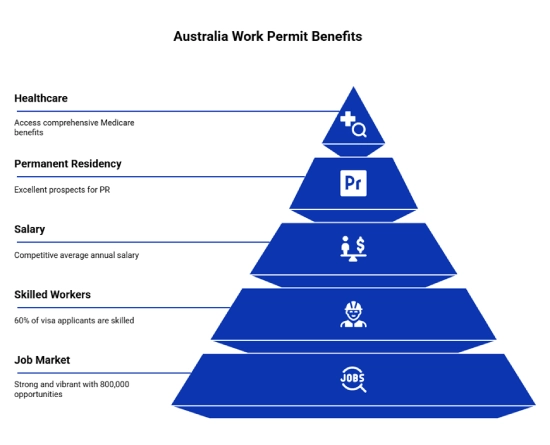
Why Choose an Australian Work Visa?
An Australia work permit allows eligible applicants to legally work in the country for a specified period. These permits are issued under various visa subclass, including temporary and permanent visas, tailored to different needs such as skilled migration, employer sponsorship, or working holiday programs. According to the Australian Government Department of Home Affairs, over 200,000 work visas were granted in the last financial year, reflecting the country's commitment to attracting global talent.
* Want to work in Australia? Start here to get expert guidance with Migrate to Australia.
Australia’s New Core Skills Occupation List (CSOL)
The Core Skills Occupation List (CSOL) identifies occupations eligible for skilled migration visas. It is regularly updated to reflect Australia's labor market needs. The latest CSOL includes occupations such as engineers, IT professionals, healthcare workers, and tradespeople. Applicants must have relevant qualifications and experience in a nominated occupation listed on the CSOL to be eligible for certain visas.
Australia Work Visa for Immigrants
Australia is one of the leading destinations for skilled migrants seeking work opportunities and permanent residency. Applicants can apply for several types of Australia work visas, including the Skilled Independent Visa (subclass 189), Temporary Skill Shortage Visa (subclass 482), and Employer Nomination Scheme (subclass 186). In 2023, skilled work visa grants reflected strong demand across various skilled occupations, highlighting Australia's appeal as a top migration destination.
Types of Australian Work Visa
Australia consistently ranks among the top countries globally for quality of life, with excellent healthcare, education, and social services. Workers benefit from robust workplace protections, including minimum wage laws and safe working conditions, making Australia an attractive destination for employment. Below are the types of Australian work visas:
Australia Permanent Work Permits
Australia offers several permanent work permits that allow foreign workers to live and work indefinitely in the country. These visas provide access to benefits such as Medicare healthcare, social security, and the ability to sponsor eligible family members for visas. The most common permanent work permits include:
- Employer Nomination Scheme (subclass 186)
- Skilled Independent Visa (subclass 189)
- Regional Sponsored Migration Scheme (subclass 187)
- Business Innovation and Investment Visa (subclass 188, permanent streams)
- Distinguished Talent Visa (subclass 124/858)
Australia Temporary Work Permits
Australia's temporary work visas allow foreign workers to live and work in the country for a limited period, addressing skill shortages and providing pathways to permanent residency in some cases. These visas require applicants to meet specific eligibility criteria and comply with visa conditions, including working in the nominated occupation and for the sponsoring employer.
Common types of Australia temporary work visas include:
- Temporary Skill Shortage Visa (subclass 482)
- Temporary Work (Short Stay Specialist) Visa (subclass 400)
- Temporary Work (International Relations) Visa (subclass 403)
- Training Visa (subclass 407)
- Seasonal Worker Program Visa
Benefits of an Australia Working Visa
Holding an Australia working visa comes with several benefits that make living and working in Australia attractive, including:
- Access to the Australian labor market with opportunities across various industries.
- Competitive wages aligned with Australian standards.
- Eligibility for social security benefits depending on visa type.
- Potential pathway to apply for Australian permanent residency.
- Ability to bring eligible family members under family visas.
- Strong workplace protections and employee rights.
- Access to public healthcare services through Medicare.
- The working holiday visa option for young people to work and travel in Australia.
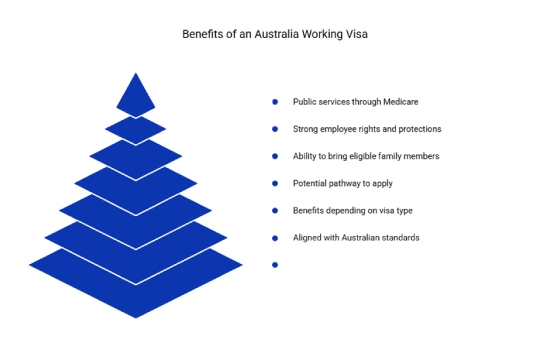
Eligibility Criteria for Australian Work Visa
Eligibility to work in Australia requires meeting the following criteria:
- Holding a valid work visa or permit suitable for your skills and circumstances
- Meeting age limits specified for the visa subclass
- Successfully completing a skills assessment by an authorized body, if applicable
- Demonstrating English language proficiency as required
- Passing health and character checks mandated by Australian immigration authorities
- Obtaining employer or state government nomination or sponsorship, if required
- Complying strictly with visa conditions, including working in the nominated occupation and maintaining employment status to retain work rights
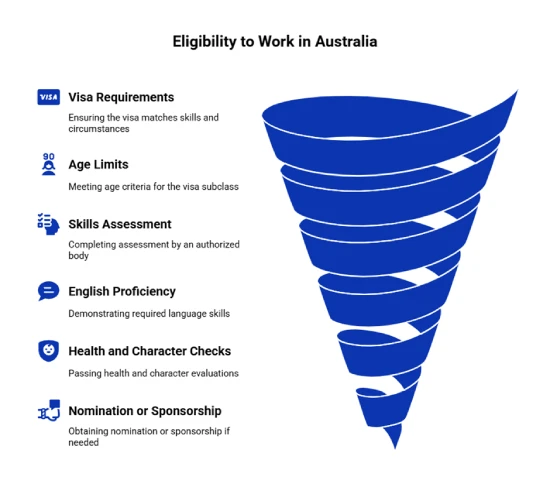
Australia Work Visa Requirements
Work visa requirements vary depending on the visa type, but generally include the following key elements:
- Valid Passport: Applicants must hold a current and valid passport from their country of citizenship to apply for an Australian work visa.
- Proof of Skills and Qualifications: Evidence of relevant skills, qualifications, and work experience related to the nominated occupation is required. This may include educational certificates, professional licenses, and employment references.
- English Language Proficiency: Applicants need to demonstrate sufficient English language ability, usually through standardized tests such as IELTS or TOEFL, to ensure effective communication in the workplace.
- Health and Character Clearances: Applicants must undergo medical examinations to meet health standards and provide police clearance certificates to confirm good character.
- Job Offer or Sponsorship: Certain visa subclasses require a valid job offer from an Australian employer or sponsorship by a registered business or state government.
- Visa Application Submission: Applicants must complete and submit their visa application through the official Australian Government Department of Home Affairs website, ensuring all required documents are included.
- Payment of Applicable Fees: Visa application fees must be paid as part of the submission process.
- Complete and Accurate Documentation: All supporting documents must be thorough, accurate, and up to date to prevent processing delays or refusals.
Meeting these requirements is essential to successfully obtain an Australia work permit and comply with visa conditions throughout the visa period.
Jobs in Australia – Top Industries and Salaries
Australia's job market is diverse, with strong demand in sectors such as healthcare, engineering, information technology, construction, and hospitality. The Australian Bureau of Statistics reported an unemployment rate of 3.7% in early 2024, indicating a robust job market. Skilled workers in occupations on the CSOL or other eligible lists have higher chances of securing employment and sponsorship.
Most In-Demand Job Sectors in Australia:
- Healthcare and Social Assistance
- Information Technology and Telecommunications
- Engineering and Construction
- Education and Training
- Hospitality and Tourism
- Mining and Resources
- Agriculture and Agribusiness
- Financial and Professional Services
- Manufacturing and Trades
- Creative and Digital Media
| Rank | Job Role | Average Annual Salary (AUD) |
|---|---|---|
| 1 | Software Engineer | 1,10,000 |
| 2 | Registered Nurse | 85,000 |
| 3 | Civil Engineer | 95,000 |
| 4 | Accountant | 80,000 |
| 5 | Electrician | 75,000 |
| 6 | Marketing Manager | 1,05,000 |
| 7 | Construction Manager | 1,20,000 |
| 8 | Mining Engineer | 1,30,000 |
| 9 | Teacher (Secondary) | 70,000 |
| 10 | Financial Analyst | 90,000 |
How to Get a Job in Australia?
Below are the Australia work visa application process:
Step 1: Check Your Eligibility for an Australian Work Visa
Assess your eligibility for Australia work visas by reviewing the official Department of Home Affairs visa requirements. Determine the right visa type, such as temporary work visa or permanent skilled visa, check age limits, and refer to the Skilled Occupation List (SOL). Complete any required skills assessments to verify your qualifications and work experience meet Australian standards.
Step 2: Apply for Jobs in Australia
Search for jobs on Australian job portals, through recruitment agencies, or via employer-sponsored programs. Tailor your resume for Australia, highlighting your skills and experience. Explore employer sponsorship opportunities, as certain visas require a sponsoring employer.
Step 3: Network and Connect with Employers
Join Australian job fairs, industry events, and professional associations to meet potential employers. Engage in online job forums and social media groups to stay updated on job vacancies in Australia. Networking can increase your chances of securing employment and visa sponsorship.
Step 4: Apply for Your Work Visa
Submit your Australia work visa application through the official Home Affairs website. Ensure all documents, such as identity proof, qualifications, and employment evidence, are accurate and up to date. Follow visa guidelines, pay fees, and maintain your employment conditions to ensure smooth visa processing.
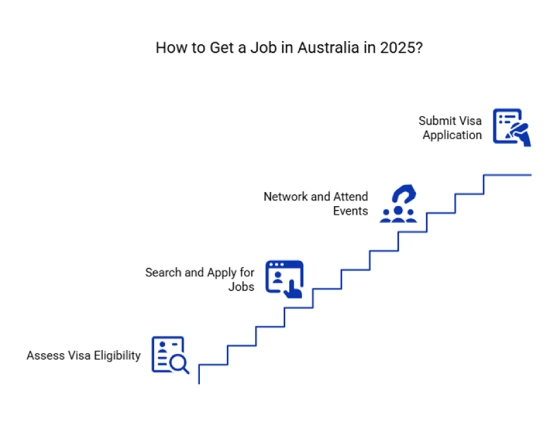
Employer Sponsorship for Australian Work Visas
Step 1: Find an eligible employer willing to sponsor you.
Step 2: Ensure the employer is an approved sponsor by the Department of Home Affairs.
Step 3: Obtain a job offer and contract from the employer.
Step 4: Employer nominates you for the appropriate visa subclass.
Step 5: Submit your work visa application once your employer’s nomination is approved.
Step 6: Follow visa conditions and start your job.
Explore pathways to permanent residency if eligible.
Australia Skills Assessment
Skills assessment is a crucial step for many skilled work visas. It involves evaluating an applicant's qualifications and work experience by an authorized assessing body relevant to the nominated occupation. This process ensures applicants meet Australian standards. For example, engineers are assessed by Engineers Australia, while healthcare professionals have specific assessing authorities. Passing the skills assessment is required for visa application eligibility.
Australian Work Visa Fees & Costs
| Visa Type | Primary Applicant Fee | Additional Applicants (Over 18) | Additional Applicants (Under 18) |
|---|---|---|---|
| Temporary Skill Shortage (TSS) Visa (subclass 482) | AUD 1,290 | AUD 1,290 | AUD 645 |
| Skilled Independent Visa (subclass 189) | AUD 4,240 | AUD 2,120 | AUD 1,060 |
| Skilled Nominated Visa (subclass 190) | AUD 4,240 | AUD 2,120 | AUD 1,060 |
| Employer Nomination Scheme (subclass 186) | AUD 4,240 | AUD 2,120 | AUD 1,060 |
| Working Holiday Visa (subclass 417) | AUD 510 | N/A | N/A |
| Temporary Graduate Visa (subclass 485) | AUD 1,650 | N/A | N/A |
| Regional Sponsored Migration Scheme (subclass 187) | AUD 4,240 | AUD 2,120 | AUD 1,060 |
| Business Innovation and Investment (subclass 188) | AUD 4,045 | N/A | N/A |
Australia Work Visa Processing Time
The processing time for an Australian work visa depends on the specific type of visa being applied for, the applicant's individual circumstances, and the documentation provided. Here is an overview of the processing times for common Australian work visas:
| Visa Type | Processing Time |
|---|---|
| Temporary Skill Shortage (TSS) Visa (subclass 482) | 4 to 6 months |
| Skilled Independent Visa (subclass 189) | 6 to 12 months |
| Skilled Nominated Visa (subclass 190) | 6 to 10 months |
| Employer Nomination Scheme (subclass 186) | 6 to 12 months |
| Working Holiday Visa (subclass 417) | 30 days (75% of applications) |
| Temporary Graduate Visa (subclass 485) | 2 to 4 months |
| Regional Sponsored Migration Scheme (subclass 187) | 6 to 12 months |
| Business Innovation and Investment Visa (subclass 188) | 6 to 12 months |
Can I get an Australian Work Permit after my study?
Yes, you can obtain an Australian work permit after completing your studies through the Post-Study Work Visa (subclass 485). This visa allows international students who have completed a qualification in Australia to live, work, and gain experience in Australia temporarily.
How Y-Axis Can Help You Get an Australian Work Visa
Y-Axis is a leading overseas education and immigration consultant. We offer expert guidance to help you secure an Australia work permit and other visas seamlessly. We assist with visa applications, skill assessments, job search support, and personalized advice to ensure a smooth migration process.
Here is the list of services we provide:
- Expert assistance with Australia work visa applications
- Support throughout the permanent residency application process
- Specialized skilled migration consulting
- Personalized study abroad counseling for international education guidance
- Immigration skill assessment services to validate qualifications
- Job placement and career guidance to help secure employment
- Tailored training and professional development programs to boost skills and employability
Looking for Inspiration
Explore what Global Citizens have to say about Y-Axis in shaping their future
Frequently Asked Questions

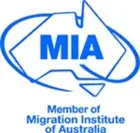

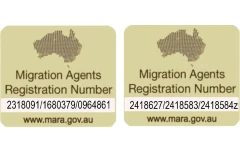
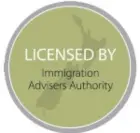
.webp)

.webp)

